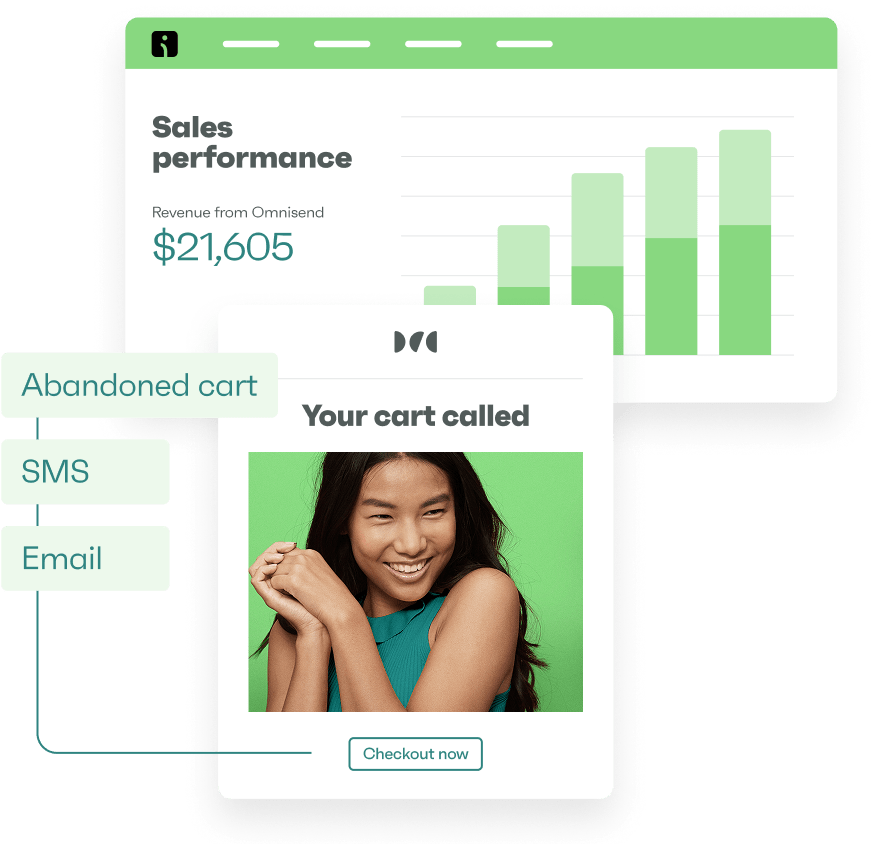
Drive sales on autopilot with ecommerce-focused features
See FeaturesEmail automation significantly boosts revenue, generating nearly 40% of email-driven sales while comprising just 3% of total sends, highlighting its efficiency in customer engagement.
Automated emails, triggered by customer behavior, outperform traditional campaigns with higher open and conversion rates, making them essential for effective marketing strategies.
Key types of email automation include abandoned cart reminders, welcome messages, and back-in-stock alerts, all designed to engage customers at critical moments in their journey.
Utilizing a robust email automation tool, like Omnisend, allows businesses to create tailored workflows that enhance customer relationships and drive sales without ongoing manual effort.
A customer abandons their cart. Half an hour later, an automated email brings them back, and the sale is saved. That’s just one scenario where email automation works, and there are dozens more throughout your customer journey.
There are moments where automated messages are essential, such as order confirmations, timely, such as back-in-stock alerts, and strategic, such as winback series.
In any case, automated emails arrive when your customers need or benefit from them, and your email marketing tool handles them all once you set up flows with appropriate triggers.
Is setting them up worth your while? A resounding yes. Omnisend’s preliminary data for Q1–Q3 2025 shows that automated emails accounted for nearly 40% of all email-driven revenue, despite making up only about 3% of total send volume.
In this 2026 edition of our email automation guide, we’ll cover the latest statistics, automation types, 15 real-world examples, setup steps, and tools you can use to get started.
Quick sign up | No credit card required
What is email automation?
Email automation is the sending of emails to your customers based on triggers you set in software, such as browsing behavior, purchase events, and segment activity.
Compared to email campaigns, which are scheduled or immediate, automations reach customers at unique moments in their journey and provide the cohesive experience you know from the likes of Amazon and other successful retailers.
Automated emails are a subset of marketing automation, which also includes SMS, push, and social channels. You need these additional automations, too, but email is by far your best opportunity to own your customer experience.
With Omnisend or another email automation tool, you can create flows to:
- Recover abandoned carts and reduce lost sales
- Welcome new subscribers and build relationships
- Re-engage inactive customers before they churn
- Confirm orders and keep customers informed
- Upsell and cross-sell based on purchase history
The image below shows an example flow for an abandoned cart email:
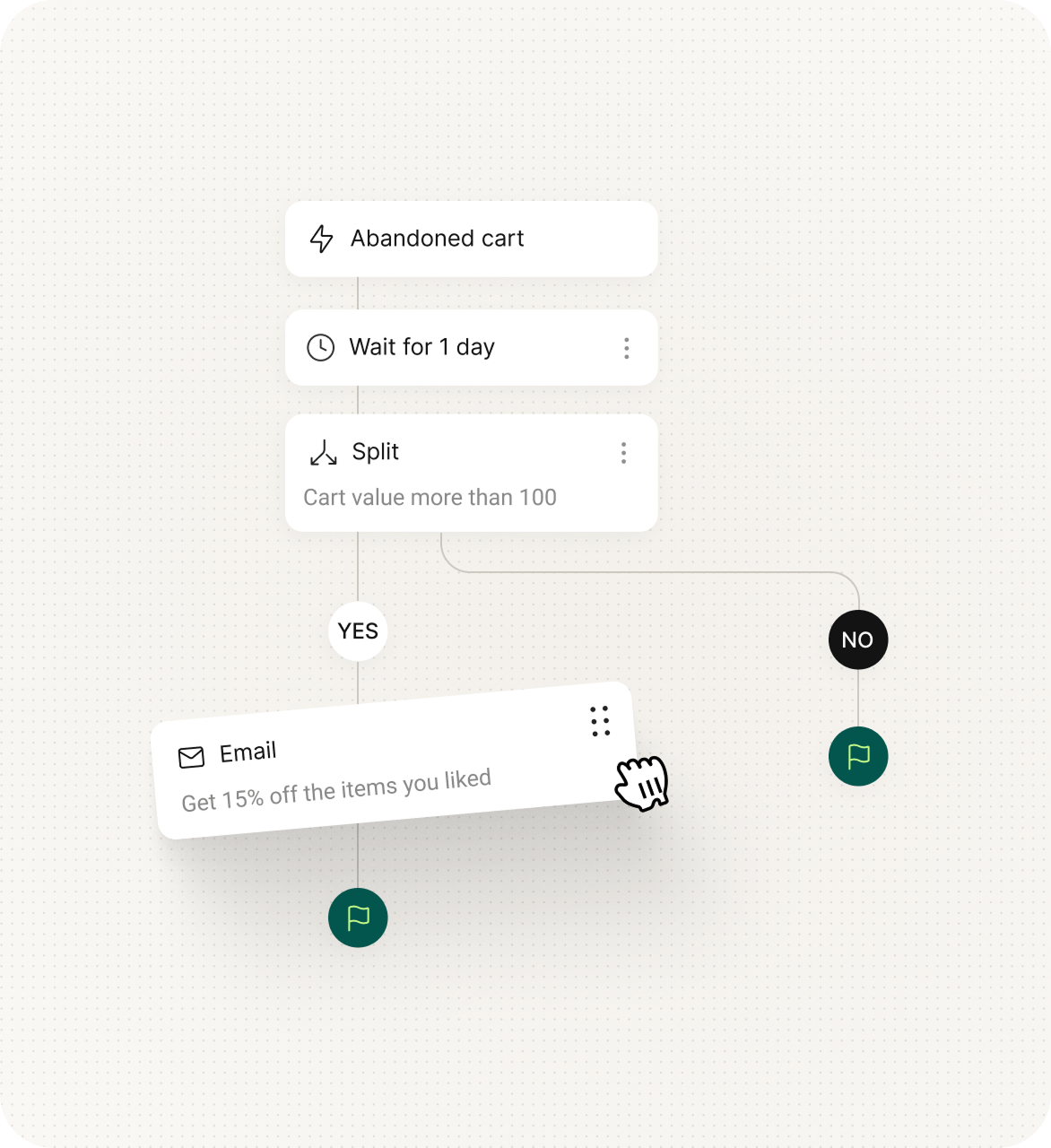
“Based on Omnisend’s internal data for Q1–Q3 2025, automated emails generated nearly 40% of all email-attributed revenue while accounting for roughly 3% of total send volume. The largest share of automated orders continues to come from three high-intent flows — abandoned cart, welcome, and browse abandonment — underscoring that timely, behavior-based messaging consistently outperforms one-off campaigns.”
—Evaldas Mockus, VP of Growth at Omnisend
Common types of email automation
We’ve compiled a list of email automations you can use in your customer journey, with performance metrics based on our internal preliminary Q1–Q3 2025 data. They include:
- Order confirmation email: Your customer gets all their order details automatically, confirming their transaction and assuring them you have their order. In our data, 55.9% opened these, and 1.59% converted.
- Shipping confirmation email: These messages include the tracking number and carrier information, letting customers watch their package’s journey to their door. Opens hit 62.9% — the highest of any automation — with conversions at 2.08%.
- Back-in-stock email: Alert customers when products they wanted are available again. These timely notifications delivered a massive 6.41% conversion rate in our data, the highest of any automation, with a 57.3% open rate.
- Birthday greeting email: Send customers a personalized message with a discount or offer when their birthday arrives. They achieved an impressive 41.4% open rate.
- Abandoned cart email: Shopping interrupted? These friendly reminders bring customers back to items they were interested in but didn’t purchase. We saw 36.8% open them and 1.69% complete their purchase.
- Abandoned checkout email: These sit one sequence ahead of cart abandonment to recover revenue lost at the very last stage in your customer’s journey.
- Browse abandonment email: You can trigger these for customers who submit their email address but leave without adding any products to their cart.
- Welcome emails: Say hello with introduction emails that warmly greet new subscribers. These have an extremely high open rate (34.1%) and conversions matched shipping emails at 2.08%.
- Cross-sell and upsell email: You’ll suggest other items your customers might love or premium versions of products they already enjoy. 42.3% opened these, but just 0.84% bought.
- Re-engagement email: Wake up dormant relationships with these “we miss you” messages that entice inactive customers to return with fresh content or special deals. A 33.0% open and 0.53% conversion rate isn’t too shabby.
- Feedback request email: Ask what your customers think about their recent purchase or experience to collect reviews for your marketing campaigns. Half opened them (51.2%), and 0.97% converted.
- Milestone celebration email: For anniversaries, achievements, and other important moments. These build connections even when immediate sales aren’t the goal.
- Education drip email: Teach your customers with a sequence of helpful tips, tutorials, and product insights delivered over days or weeks. The payoff comes from better product adoption, not quick conversions.
Here are our Q1–Q3 2025 email automation benchmarks in a table, weighted by conversion rate:
| Automation type | % of active brands using it | Open rate | Conversion rate (orders/sent) |
|---|---|---|---|
| Back-in-stock | 1.5% | 57.3% | 6.41% |
| Welcome | 59.1% | 34.1% | 2.08% |
| Shipping confirmation | 4.5% | 62.9% | 2.08% |
| Abandoned cart | 59.7% | 36.8% | 1.69% |
| Order confirmation | 10.3% | 55.9% | 1.59% |
| Order follow-up | 5.8% | 48.2% | 1.06% |
| Customer feedback | 0.35% | 51.2% | 0.97% |
| Cross-sell | 2.6% | 42.3% | 0.84% |
| Product viewed | 16.7% | 42.2% | 0.80% |
| Birthday | 2.0% | 41.4% | 0.63% |
| Page viewed | 3.1% | 41.7% | 0.54% |
| Customer reactivation | 9.6% | 33.0% | 0.53% |
As you can see, back-in-stock, welcome, shipping confirmation, abandoned cart, and order confirmation emails had the highest conversion rates, with customer reactivation emails sitting at rock bottom (a byproduct of unengaged recipients).
Automated emails vs. email campaigns vs. bulk emails vs. drip campaigns
Automated, bulk, and drip emails play different roles in your customer journey:
- Email automations trigger based on what people do or which segment they join, such as completing a purchase or leaving items in their cart.
- Email campaigns include newsletters and sales events, and they go out when you decide. Announce a sale today, schedule a newsletter for Friday, whichever timing works.
- Bulk emails deliver one message, such as a new product drop, to thousands of people simultaneously and are a type of campaign.
- Drip campaigns consist of multiple emails sent days or weeks apart, such as a welcome series that escalates offers over one, three, and five days.
You will use all these email types across your marketing strategy, although automations and campaigns will make up most of your efforts.
Here’s a table explaining how they work and differ in more detail:
| Aspect | Email automation | Email campaigns | Bulk emails | Drip campaigns |
|---|---|---|---|---|
| Definition | Triggered by user actions | Scheduled or one-time sends for marketing activities | Mass emails to a large audience | Pre-scheduled series over time |
| Personalization | High, tailored to individuals | Moderate, based on segment or timing | Low, one-size-fits-all | Moderate, based on segment or timing |
| Trigger-based | Yes, based on actions | No, sent manually or on schedule | No, sent manually | Yes, scheduled over time |
| Purpose | Nurture leads, engage users | Promote offers, share news, encourage action | Make a broad announcement | Educate or guide users |
| Use cases | Welcome, cart reminders | Product launches, sales, announcements | Newsletters, promotions | Onboarding, lead nurturing |
| Frequency | Automated, user-triggered | Single or periodic send | Single or periodic send | Automated, timed sequence |
| Engagement | High, due to relevance | Moderate, content-dependent | Moderate, content-dependent | Consistent engagement over time |
| Working example | Abandoned cart email | Holiday sale announcement | Newsletter | Three-week email sequence |
Additional reading
30+ email marketing campaign examples, types and tips
Email marketing automation tools (software and comparison)
Pricing, features, and complexity separate email automation platforms. Some handle intricate workflows. Others blast emails to lists.
Your budget sets limits, but don’t ignore learning curves or whether the platform will scale with your list growth trajectory. Migrating thousands of contacts and rebuilding workflows across all platforms isn’t easy.
Does it connect to what you already use? Can you understand the reports? Will support answer when something breaks?
Omnisend takes the lead in free email automation, allowing you to build unlimited flows, send up to 500 emails/month, and combine email and SMS in automations.
Compare the best platforms below:
| Email automation tool | Pricing (starting at) | Best for | USP | Key features | Free plan |
|---|---|---|---|---|---|
| Omnisend | $16/month | Ecommerce marketing for stores of all sizes | Omnichannel marketing across email, SMS, and push | Advanced segmentation, SMS integration, product recommendations, cross/omnichannel marketing, pre-built automation workflows | Yes, 250 contacts and 500 email sends/month |
| Sender | $10/month | Mass sends and affordable email marketing | Generous sending volumes for bulk campaigns | Drag-and-drop editor, automation workflows, newsletter templates, transactional emails | Yes, 2,500 contacts and 15,000 emails/month |
| Brevo | $9/month | Small- to medium-sized businesses | Optional sales automation with deals and pipelines | Transactional emails, SMS campaigns, in-depth analytics | Yes, 300 emails/day and 2,000 contacts |
| Klaviyo | $20/month | Large ecommerce stores | Granular flow and segment builders | 350+ integrations, generative AI, customer profiles with all-time data | Yes, 500 emails/month for 250 contacts |
| Moosend | $9/month | Small businesses seeking affordable options | AI tools that analyze audience behavior | Marketing automation workflows, landing pages, subscription forms, AI-powered product recommendations | No |
| HubSpot | $15/month/seat | Inbound marketing and CRM | Additional marketing tools, many of which are free | CRM integration, lead scoring and management, advanced workflow builder, multi-channel campaigns | No |
| Constant Contact | $12/month | Non-profits and small businesses | 1:1 onboarding across all paid plans | Drag-and-drop editor, real-time tracking, event management, social media marketing, and integration | No |
| MailerLite | $10/month | Startups and budget-conscious users | Website and landing page builders | Simple automation, landing pages, basic analytics, website builder | Yes, 12,000 emails/month to 500 subscribers |
| Kit | $39/month | Creators and bloggers | Content monetization features | Predictive sending, split automation, site tracking, CRM tools | Yes, unlimited email broadcasts to 10,000 subscribers |
| ActiveCampaign | $15/month | Advanced marketers and B2B companies | AI business goals and predictive sending | Predictive sending, split automation, site tracking, CRM tools | No |
| GetResponse | $19/month | Webinar and marketing integration | Unlimited autoresponders, free custom domain | Conversion funnels, landing pages, webinar marketing and hosting, autoresponders | Yes, 500 contacts and 2,500 emails/month |
| Drip | $39/month | Ecommerce marketing and personalization | Unlimited email sends across all plans | Personalized workflows, revenue attribution, behavior-based automation | No |
| Mailchimp | $13/month | Beginners and service businesses | 250+ integrations | Easy-to-use templates, audience insights, A/B testing | Yes, 1,000 emails/month and 500 contacts |
| EmailOctopus | $10/month | Simple and affordable email marketing | Unlimited landing pages and forms | Affordable pricing, simple campaigns, integration with Amazon SES | Yes, 2,500 subscribers and 10,000 emails/month |
How to choose email automation tools
Consider these factors when picking between email automation apps:
- Single versus multichannel automations: Some tools only handle email, while others handle additional channels, such as email and SMS, to reach customers in multiple places. Check out each tool’s channel support and whether you need to pay extra for access.
- Segmentation capabilities: Your tool should ideally have pre-built segments and an intuitive segment builder for custom configurations. Omnisend goes further with an AI segment builder, letting you group customers with prompts.
- Pricing variations: You’ll pay based on either the number of contacts or email send volume. Which suits you better? That depends on whether you have a large list or extensive sending requirements.
- Support levels: Email support is the bare minimum, and live chat is even better for troubleshooting and working your way around features.
- Ecommerce integrations: The best email apps have native apps for Shopify, WooCommerce, BigCommerce, Six, and other platforms. If you have a custom build, you should look for API access.
- Integrations with additional apps: You probably have several apps integrated into your ecommerce store and marketing activities, such as Salesforce (a CRM) and Facebook Lead Ads. Tools with native apps for these will save you significant time.
How to automate emails effectively (step-by-step guide)
Automating emails requires the right approach to drive results. Here’s how to set up your email automation system properly:
1. Choose an email marketing tool
Building automations that improve your sales and customer experience starts with picking the right email automation software.
Don’t just pick the most popular option. Instead, evaluate how different marketing automation platforms help you reach people and build unique customer journeys.
Can it segment users the way you need? Does it handle transactional email? Will it connect with your tools? Does the analytics dashboard show metrics you care about?
Price matters, too, but cheaper isn’t better if you outgrow it in six months. Look for free forever plans (Omnisend offers one of these) and free trials, and match the tool to where your business is heading, not just where it stands today.
2. Set up IP pools (if applicable)
IP pools improve email deliverability, providing multiple highways for your messages instead of a single congested road. Without proper IP management, your carefully crafted emails might land in spam folders when sent at volume.
Many email platforms handle this invisibly, while others require manual configuration. If you send over 100,000 emails monthly, ask your provider about dedicated IPs — they’re worth the investment to protect your deliverability and maintain sender reputation.
3. Build and segment an email list
Segmentation is a best practice that stops you from sending product recommendations to people who have just bought, welcome emails to long-time customers, or win-back campaigns to active subscribers.
In other words, segments ensure your email marketing flows target the right people.
Collect subscriber information through signup forms on your website, landing pages, and social media. Then, divide your audience into meaningful groups based on the following:
- Behavior: Past purchases, browsing history, and email engagement
- Demographics: Age, location, and other relevant characteristics
- Purchase patterns: Frequency, average order value, and product preferences
- Engagement level: Active readers versus inactive subscribers
If you’re subscribing to your first email marketing tool and already have a contact list, upload your email list to the tool and use pre-built segments for a head start.
Omnisend has pre-built segments, or you can create them from scratch:
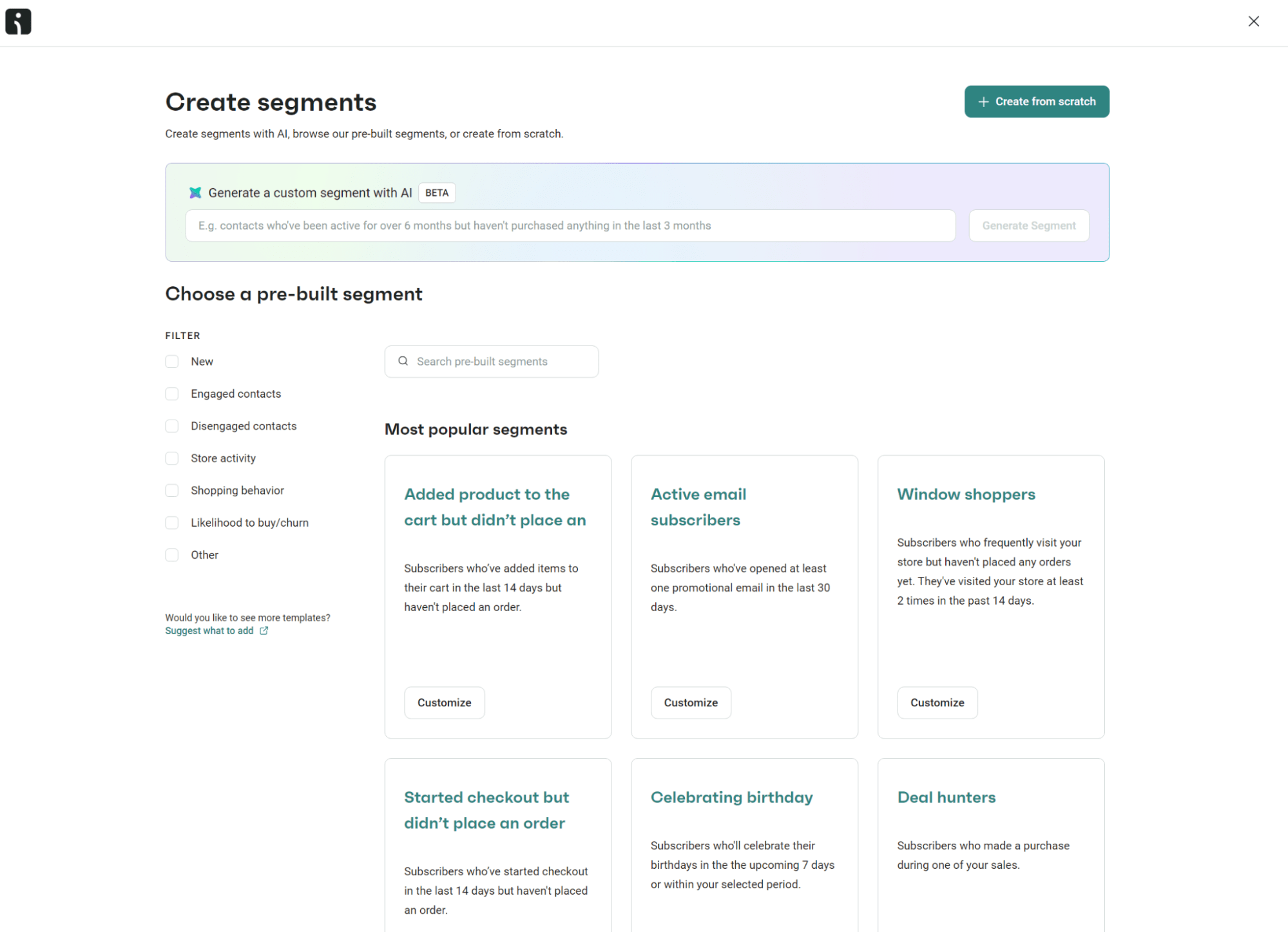
Learn more about segmentation:
Email segmentation: 7 proven strategies to get started
4. Decide your automation workflows
Your ecommerce email workflows should include sequences that mirror the natural customer journey. Start with welcome messages, continue through engagement and purchase stages, and extend to post-purchase follow-ups.
Omnisend has pre-built automations, including:
- Welcome: When someone joins your list
- Purchase: After completing an order
- Abandonment: When leaving items in a cart
- Behavioral: After viewing specific products
- Time-based: Birthdays or anniversaries
- Re-engagement: When inactive for a set period
- Back-in-stock alerts: Based on inventory updates
- Replenishment: When subscriptions are up for renewal
These automations have triggers, delays, messages, and exit conditions preconfigured. Here’s an example of a stock welcome series automation in Omnisend:
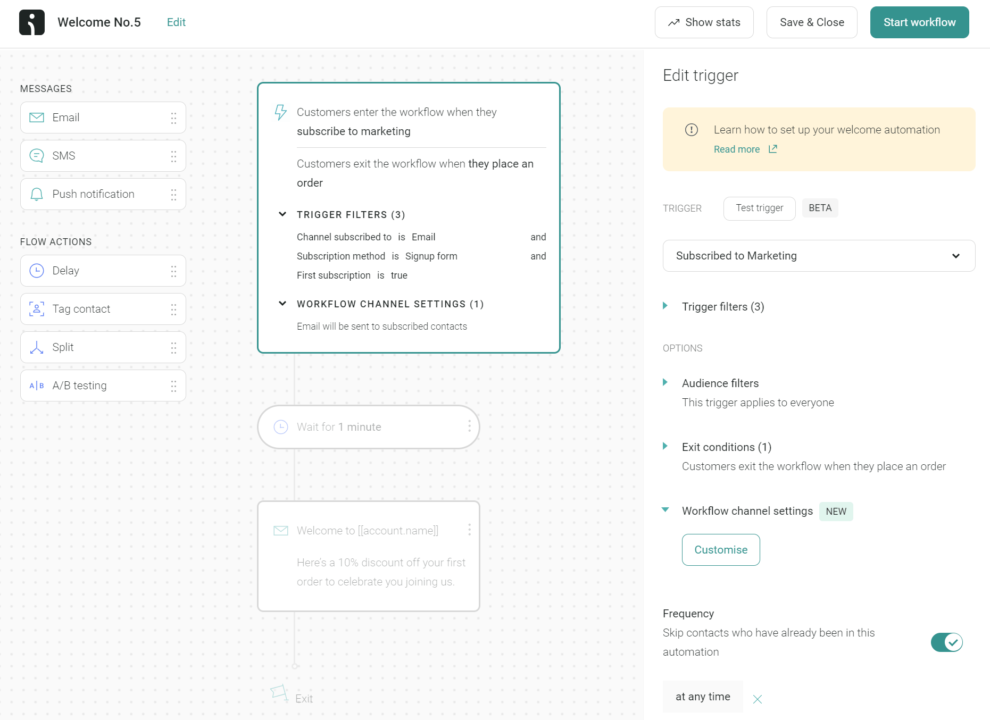
5. Edit/build your workflows
When building workflows, consider four critical elements:
- The quality of your email design and content
- Timing intervals between messages
- Branch points where customers might take different paths based on their behavior
- Exit conditions that remove people from sequences when appropriate
Consider drawing your flow on paper before building it, or use your email tool to create a basic sequence in its flow editor. Here’s an example in Omnisend:
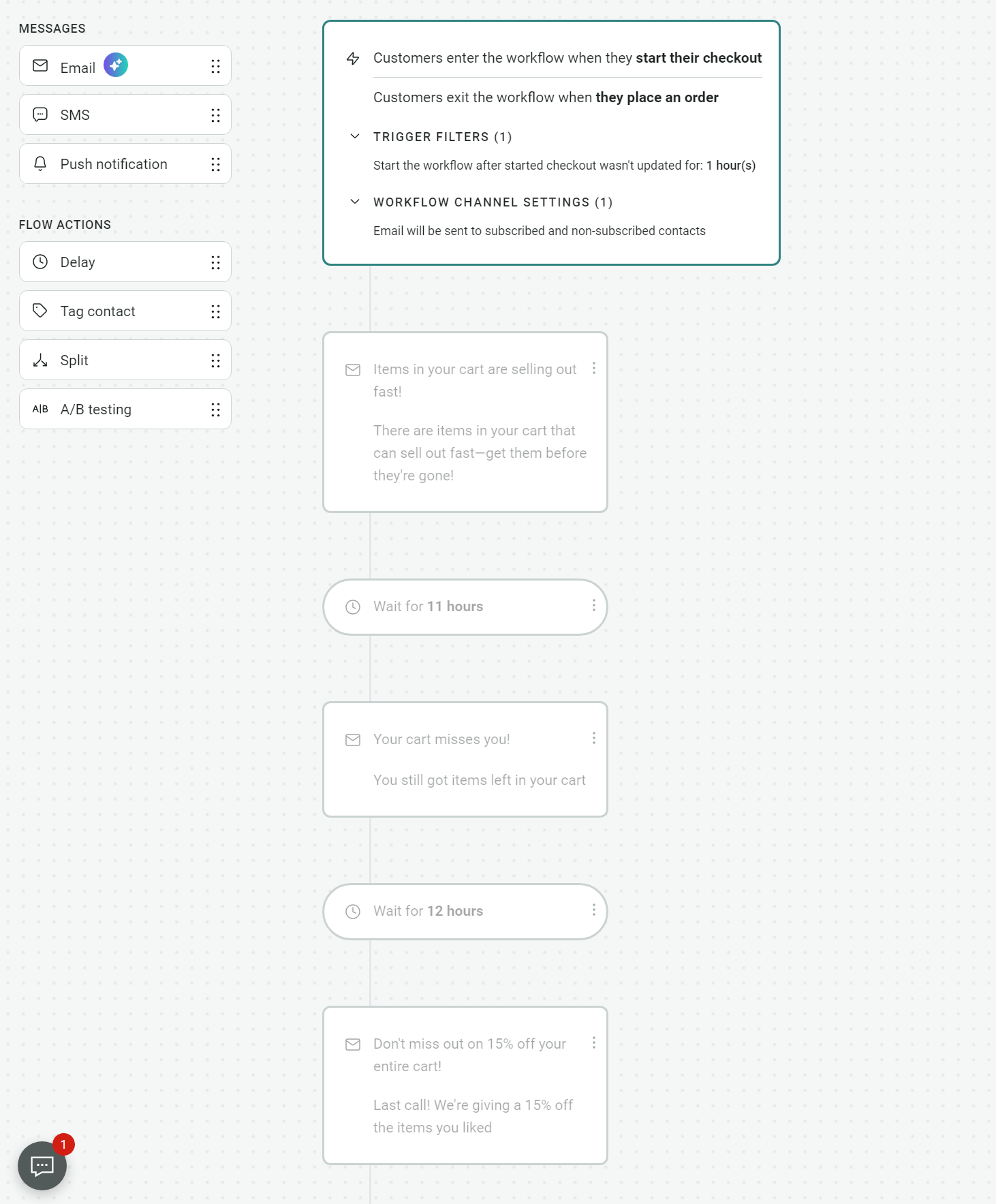
Flow actions control what happens after a trigger activates your automation. These actions include sending emails, waiting periods, moving subscribers between segments, or ending sequences based on behavior.
Take a cart abandonment scenario. First, it nudges shoppers with a gentle reminder showing the forgotten items. If that doesn’t work, it can follow up a day later with a limited-time discount.
When customers take advantage of that offer, you can flag them in your system as responsive to deals to tailor future offers accordingly.
Once you’ve built your flow, testing it is best practice to ensure that your sequence arrives on time, with the right message, to your defined audience.
Watch this video to learn how to build automated emails in Omnisend:
6. Create email templates
Most email tools have editable, pre-built email templates. Edit these to represent your brand consistently and present content effectively. Focus on:
- Clear, concise copy that gets to the point
- Mobile-friendly images and layouts that work on all devices
- Personalization fields that insert subscriber information (according to Attentive, 96% of consumers say they’re likely to purchase when brands send personalized messages)
- Calls to action that direct readers on what to do next
- Visual elements that support your message without overwhelming it
- Accessibility, such as alt text for images and links to audio email versions
Branding your emails is necessary for a consistent customer experience. Remember that most of your subscribers will have signed up on your website, so seeing the same branding again in emails builds trust and encourages engagement.
The easiest way to ensure accurate branding for all your automations and campaigns is to add your brand style to Omnisend and let it automatically apply your logo, brand colors, and social media links to every email.
Want to build high-converting emails? Use these email design best practices for 2025.
7. Add an alternative message channel
Complement your email automation with SMS or push notifications for time-sensitive information. These channels provide backup when emails aren’t opened and create a more complete communication approach that meets customers where they are.
Omnisend’s 2025 ecommerce marketing report found that US brands generated over $25 million in SMS sales alone in 2024.
Here are some scenarios where SMS and push notifications can assist your email strategy:
- SMS messaging: Urgent notifications like shipping updates, flash sales, appointment reminders, and limited-time offers where immediate attention is critical
- Push notifications: Website alerts for back-in-stock items, price drop notifications, and order status updates, where a quick tap can bring customers directly to the relevant page on your website or app
8. Monitor and optimize
Optimizing your customer journey with email automations is an ongoing process in which you’ll refine your subject lines, messaging, delays, triggers, and segments to eke out as much engagement as possible.
Your most effective changes will be those made in response to A/B tests, as well as open rates, click-through rates, conversions, revenue, and sales. Omnisend lets you track these metrics in reports, and you can use this data to:
- Adjust sending frequency and timing
- Refine audience targeting
- Improve underperforming content
- Test different subject lines and offers
- Remove friction in the customer journey
Review and update your automation sequences regularly to ensure they remain relevant and effective as your business and customer needs evolve.
Omnisend’s Advanced Reporting provides unified performance metrics across all channels, automatically identifies top-performing campaigns, and offers visualization tools to help you track trends.
Additionally, you can run A/B tests on two automation versions to see which works best. You can split participants 50/50 (or a different ratio) and see the stats for each within the automation builder. Here’s an example:
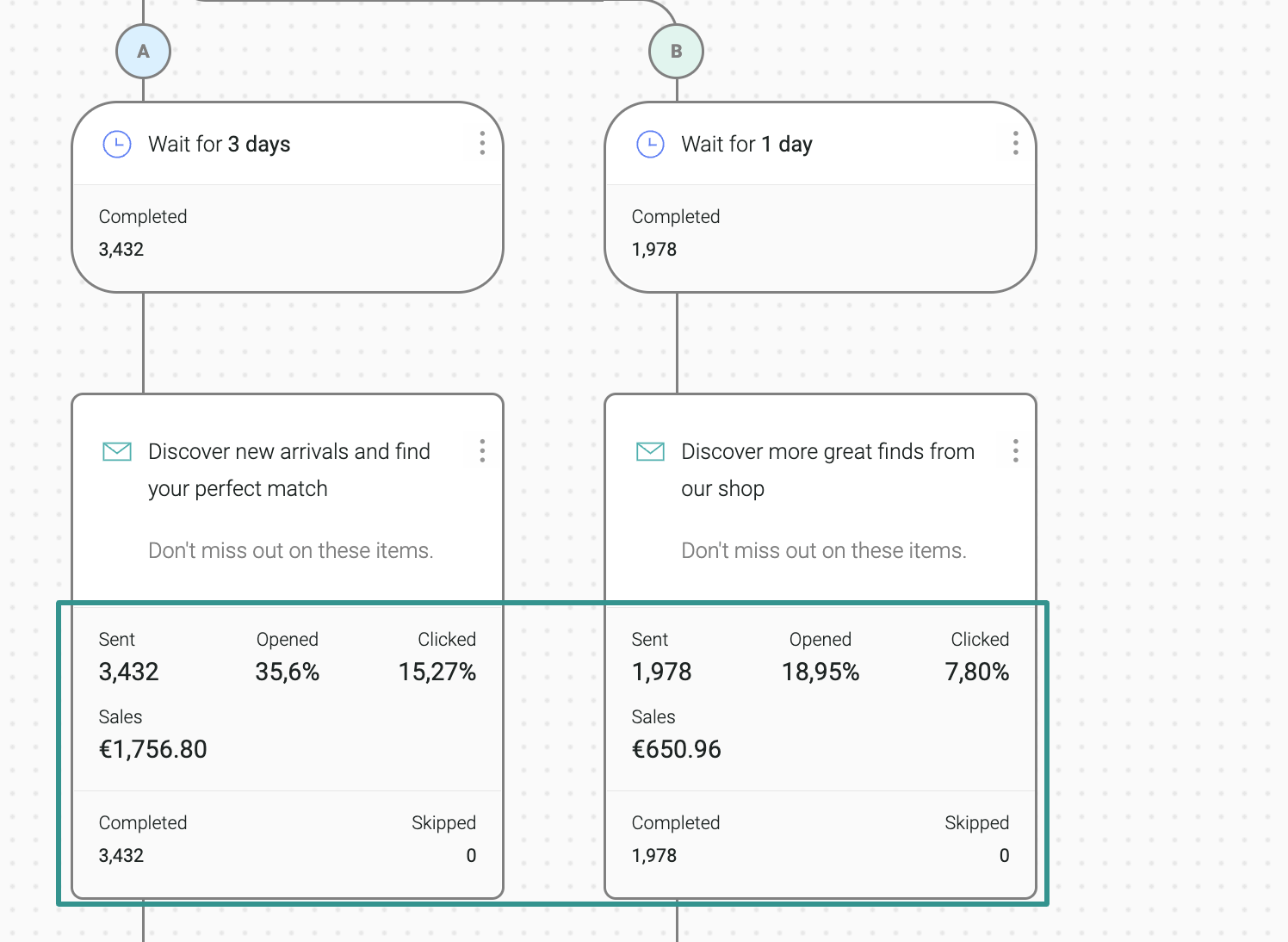
Cleaning your list is another best practice to ensure your automations only reach active and engaged customers. Removing faulty and outdated emails helps you avoid spam traps, reduce wasted sends, and save money if you’re teetering close to an upgrade based on send volume.
Benefits of email automation
Omnisend’s latest research reveals that automated emails have higher open, click, and conversion rates than scheduled messages.
Why are automations superior? Because they trigger based on behavior to reach people when they are most likely to engage and buy.
Here are the benefits of email automation for your business:
- Get measurable results that improve over time: Between Q1–Q3 2025, automated emails accounted for nearly 40% of all email-driven revenue, despite making up only about 3% of total send volume
- Create conversations that scale: Our latest data shows that automated emails averaged a 39% open rate vs 25–29% for campaigns, and a 4.7% click rate vs 0.7–1.0% for campaigns
- Deliver when it matters: Your messages arrive when customers are most receptive, whether that’s moments after purchase, when items ship, or after browsing products
- Personalization opportunities: Build flows that trigger based on browse, purchase, and segment activity with unique messaging that improves your customer relationships
- Send based on what customers do, not just who they are: Behavior-triggered emails convert at higher rates, with one in three people who click on an automated message making a purchase compared to just one in 18 for scheduled messages
- Keep more customers in your ecosystem: Abandoned carts, welcome messages, and browse abandonment emails are responsible for 80% of all automated orders, bringing wandering customers back
- Build relationships on autopilot: Send birthday messages, milestone celebrations, and re-engagement sequences that nurture customer relationships without requiring daily attention from your team
- Win more sales and achieve a better ROI: Email automations arrive at the most relevant and opportune moments in your customer journey based on triggers you set, helping capture additional purchases and increasing customer lifetime value
Real results from email automation: Omnisend customer success stories
Check out these email automation success stories to inspire your efforts:
1. Bowy Made – baby essentials
Automations generate 70% of Bowy Made’s total revenue, with pre-purchase flows like product and browse abandonment driving five-figure returns in single months. The luxury baby brand maintains a 52% average open rate across automated emails and achieves a 30% return customer rate by timing messages around customer lifecycles instead of pushing discounts.
Read the Omnisend customer story: Bowy Made.
2. Dukier – dog accessories
Revenue from Omnisend grew 525% over three years for this Madrid-based dog accessories brand, climbing from €82,857 to €518,860:Automations deliver 55% of that revenue across five localized markets, maintaining a 48.4% open rate and 0.36% unsubscribe rate. Dukier’s behavior-based sequences consistently outperform generic campaigns in both average order value and conversion.
Read the Omnisend customer story: Dukier.
3. To’ak Chocolate – confectionery
To’ak Chocolate’s welcome series converts at 18% and generates revenue-per-email 3,466% higher than promotional messages. Automated emails account for just 2.1% of sends but produce 39% of email revenue. The luxury chocolate brand increased email-generated sales by 460% after building cart abandonment and welcome sequences that tell its origin story without discounting.
Read the Omnisend customer story: To’ak Chocolate.
Email automation examples
Check out these email automation examples to inspire your own:
1. Crocs — Automated order confirmation email
Subject line: We got your order. (You have great taste!)
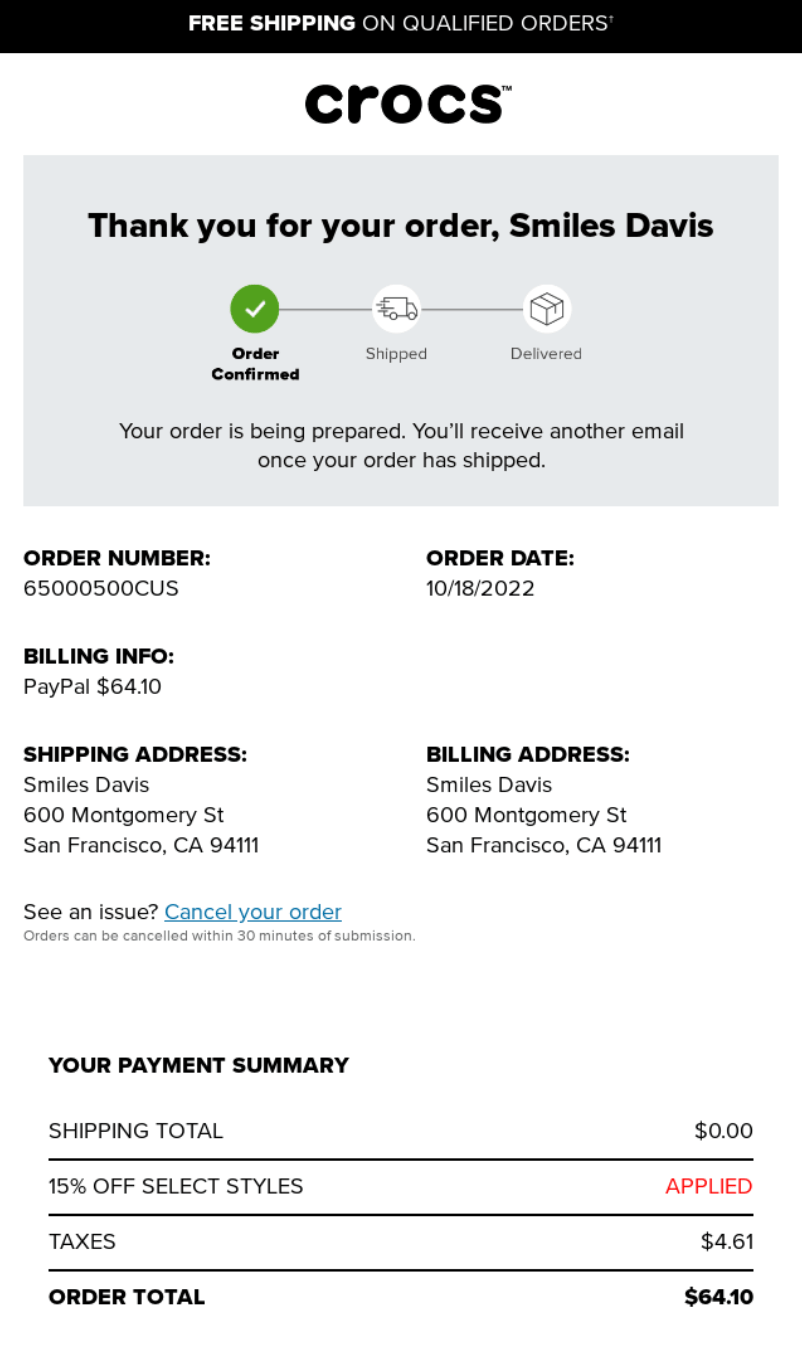
Footwear retailer Crocs uses a conversational subject line (“You have great taste!”) to confirm orders and encourage customers to open the email.
Opening it reveals a thank you note and a progress bar showing “Order Confirmed” with blanked-out “Shipped” and “Delivered” steps, helping the customer see their order status at a glance. It then details the order with a payment summary.
The email’s simplistic design emphasizes information and clarity. It has a white background, black text, and a small logo at the top.
Key takeaways
- Make your order confirmations scannable
- Progress bars help customers visualize steps
- Include all information related to the order to reduce inquiries
2. Fitbit — Automated shipping confirmation email
Subject line: Today is the day! Your order has been shipped.
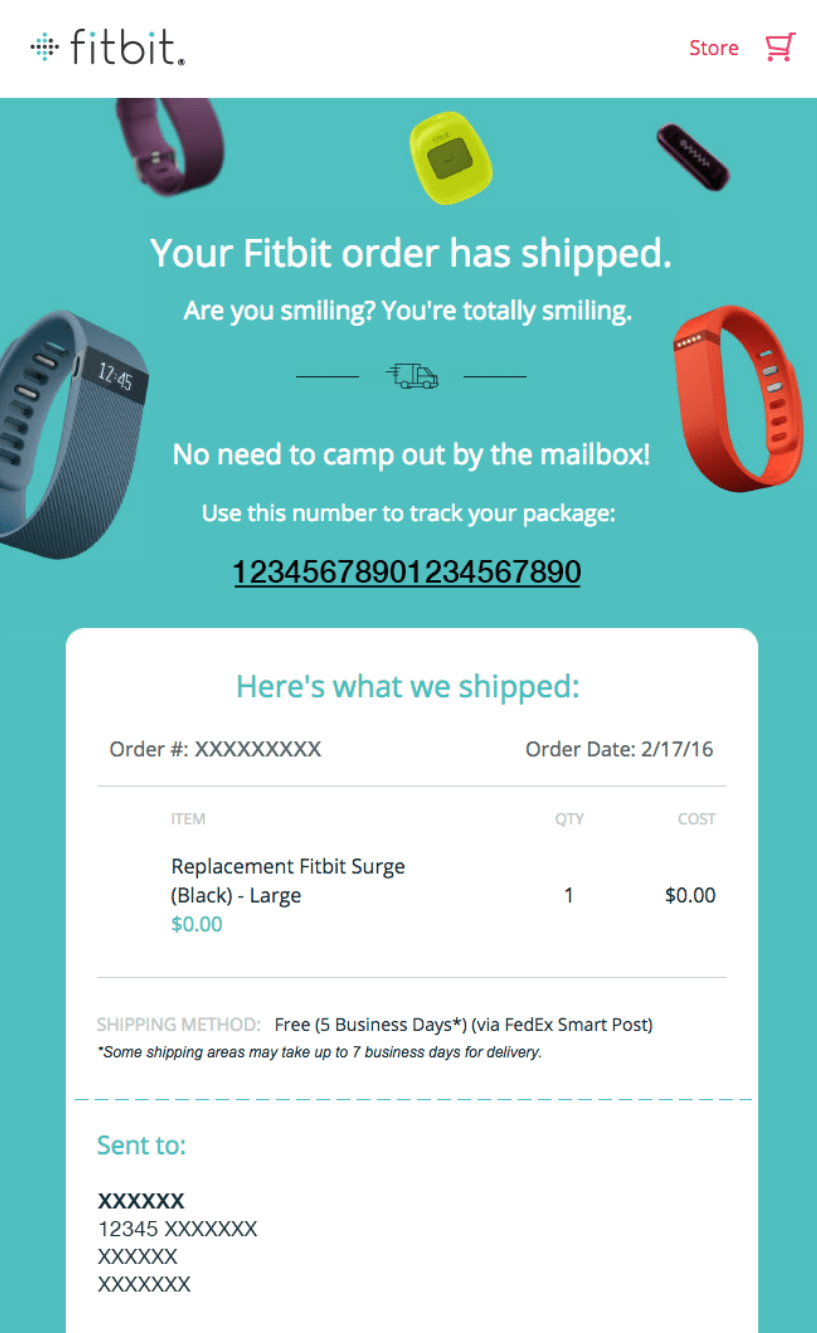
Fitness wearable brand Fitbit uses exciting writing in its shipping confirmation (“Today is the day!” “Are you smiling? You’re totally smiling.”) to create an enjoyable brand experience and set a positive tone ahead of delivery.
Its email uses a colorful background, floating product images, and a small header with a logo and store link to match its website branding. Customers can click a black tracking link and a shipping note confirming the shipment.
Key takeaways
- Shipping confirmations can be part of your brand experience
- Include tracking links and shipping method information
- Add your customer’s address to reduce anxiety over delivery
3. Starbucks — Automated birthday reward email
Subject line: Open on your birthday 🎁 (Actually, you can open now)

Starbucks sends automated birthday emails that treat its members in the lead-up to their birthdays with a free drink or food item redeemable only on their birthday.
Its subject line, “Open on your birthday 🎁 (Actually, you can open now),” uses a gift emoji to let the customer know its intent and builds anticipation with the suggestion to open.
The email design matches the Starbucks website, with a light green background and illustrations. It uses scarcity tactics to encourage action, with the heading “REDEEM ONLY ON 12/12,” and clarifies where they can find their coupon.
Key takeaways
- Rewarding customers encourages loyalty
- Appropriate emojis can increase open rates
- Clarify your offer and terms to promote action
4. Brew Tea Co — Automated abandoned cart email
Subject line: Your tea is right where you left it.
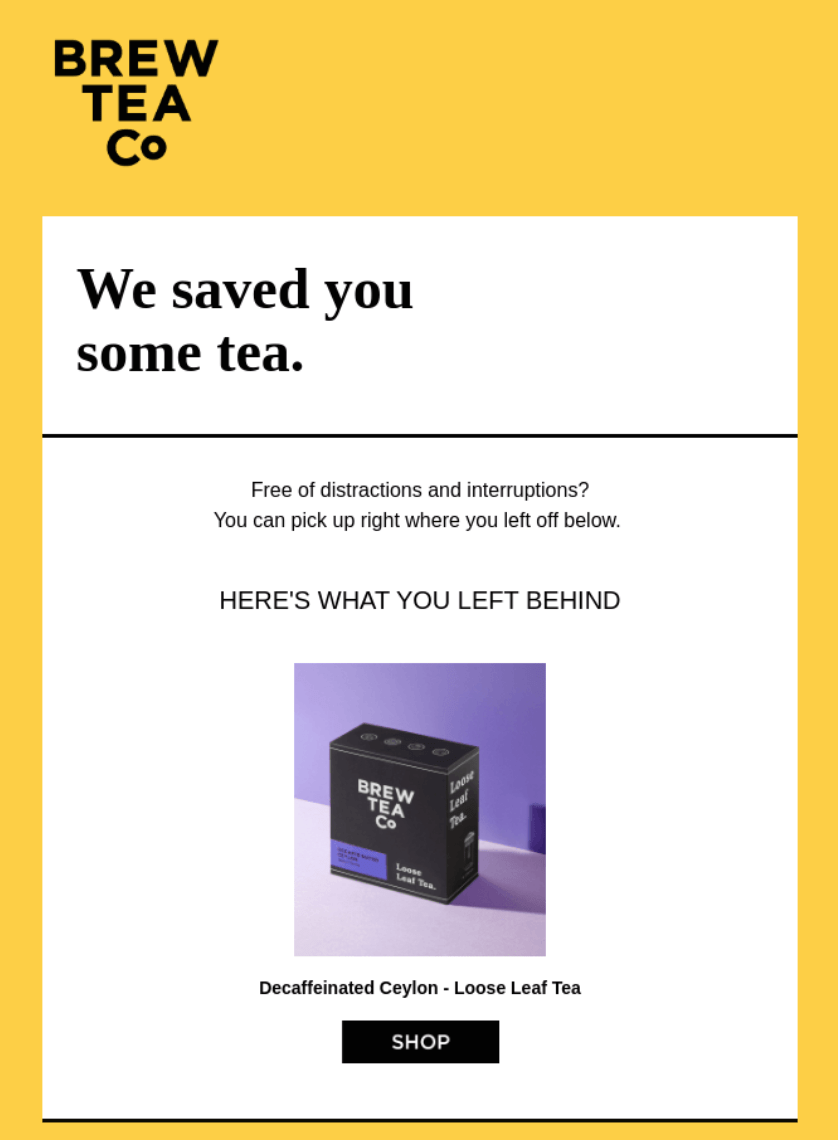
Tea retailer Brew Tea Co uses a simplistic email design and the words “Free of distractions and interruptions? You can pick up right where you left off below” to reduce friction following cart abandonment and get customers to continue shopping.
Its yellow background and white-boxed email content match the company’s website branding and put all eyes on the product. Headings like “We saved you some tea” and “HERE’S WHAT YOU LEFT BEHIND” provide reminders and pitch the email as helpful.
Key takeaways
- Abandoned cart reminders help recover revenue
- Eliminating friction makes these sequences feel helpful
- Include images of abandoned products to create familiarity
5. Bellroy — Automated welcome email
Subject line: You’re in! Welcome to the family
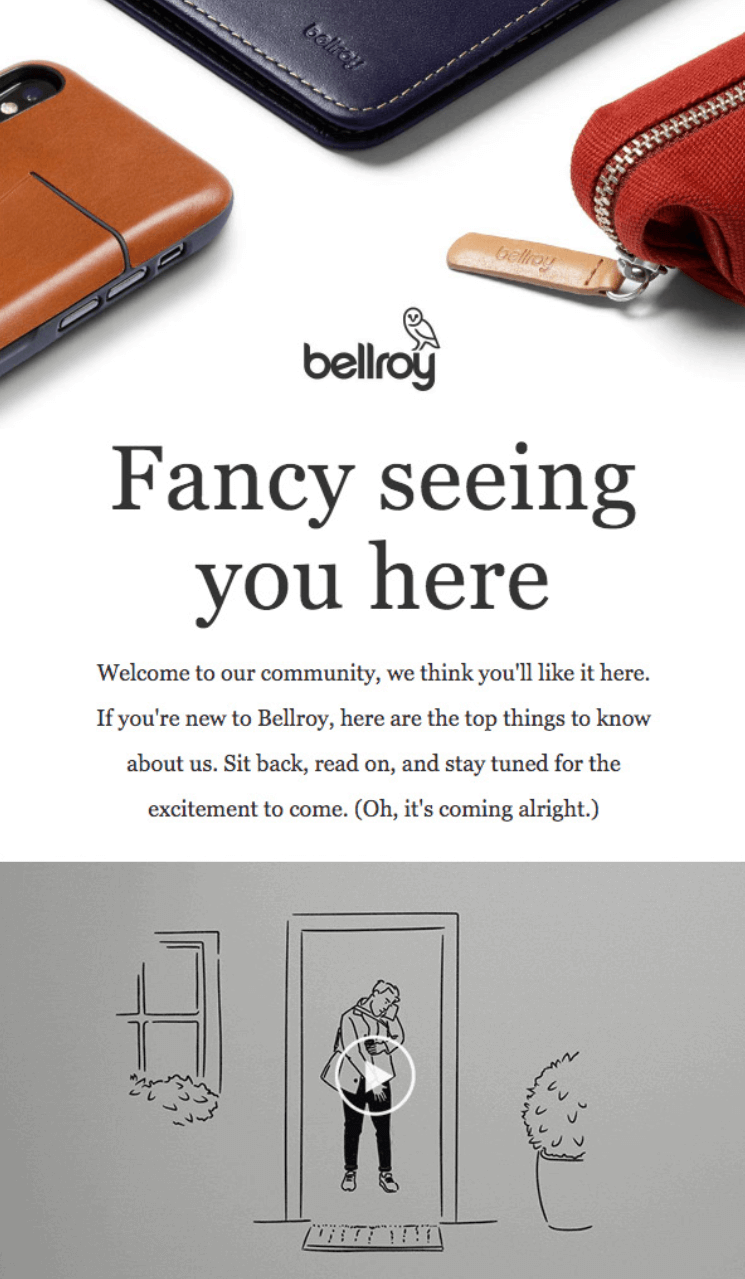
Carry goods brand Bellroy gives its welcome series a membership feel with the subject line “You’re in! Welcome to the family.” Opening the email welcomes the reader to Bellroy’s community and provides guidance and tips about the brand.
A video thumbnail opens a web page video for subscribers to find out more, or they can scroll the email to discover its Instagram account, mission, product designs, social and environmental policies, and samples of what’s to come.
The email is relatively long but effectively moves customers through a brand story, offering opportunities to shop with links to product categories.
Key takeaways
- Welcome emails can improve brand affinity
- Images and videos make your emails more interesting
- Pivoting from basic welcomes to a community approach uplifts loyalty
6. OluKai — Automated cross-sell email
Subject line: Did you see something you liked?
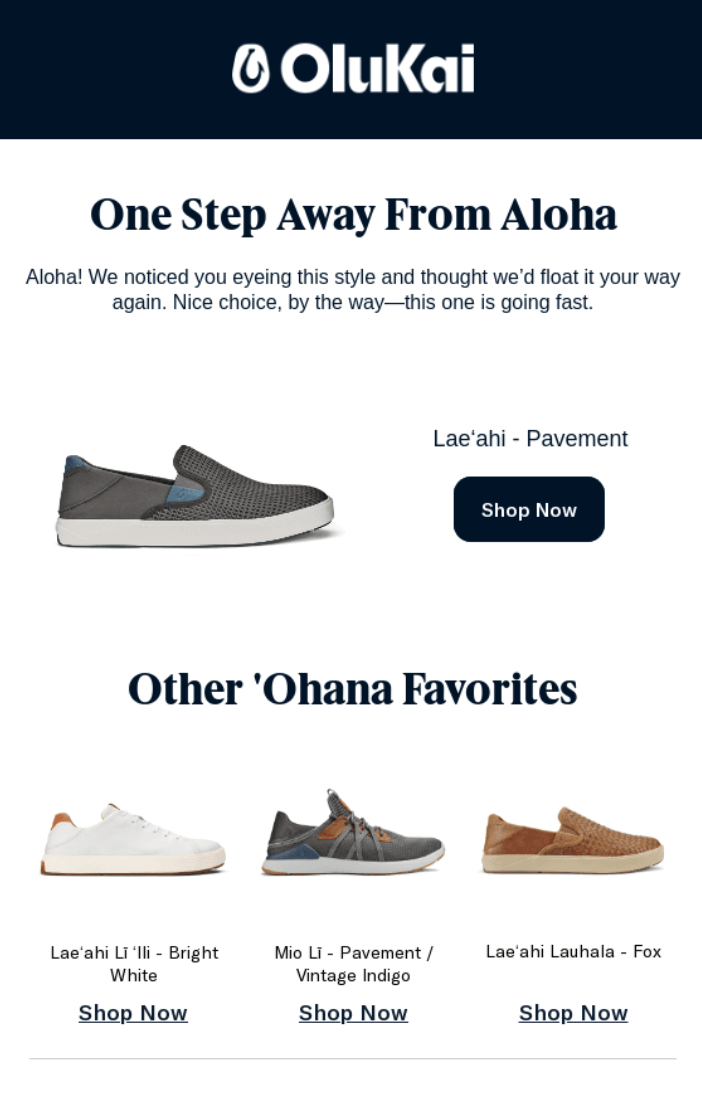
Premium footwear brand OluKai sends automated cross-sell emails based on browsing behavior. It segments subscribers by the products they view and then sends personalized recommendations to encourage purchases.
Its email references a product from a previous browsing session and includes a “Shop Now” CTA button. Below that, it lists “Other ‘Ohana Favorites” (additional products) with links.
The email’s heading, “One Step Away From Aloha,” suggests a seamless buying experience and reinforces the brand’s Hawaiian designs.
Key takeaways
- Trigger cross-sell emails based on browsing behavior to ensure proper targeting
- Referencing previous interactions builds relevance into your emails
- Personalized recommendations can introduce customers to products they love and buy
7. Cuisinart — Automated re-engagement email
Subject line: Pssst…we have a question for you.
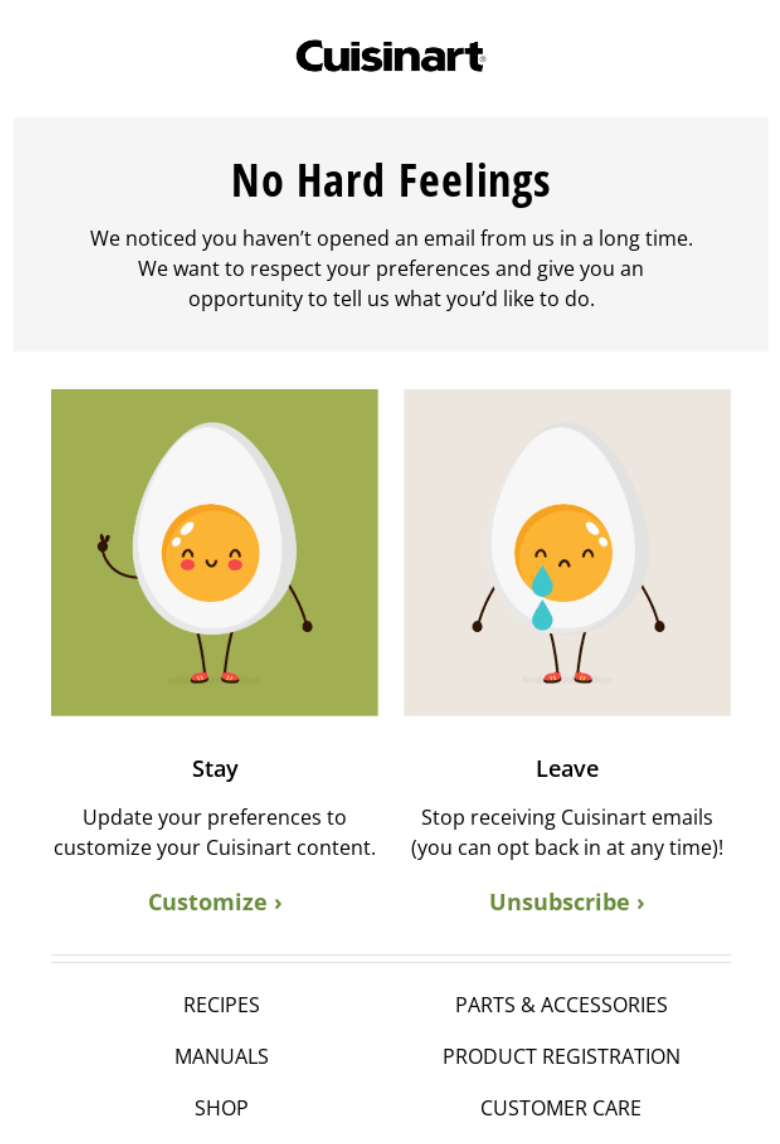
Kitchen appliances retailer Cuisinart sends re-engagement emails asking subscribers whether they want to stay subscribed or unsubscribe.
Its subject line, “Pssst…we have a question for you,” keeps things neutral before the email opens to reveal a “No Hard Feelings” heading to reduce friction. Customers can then select “Stay” or “Leave” with one click or tap (ignoring the email also keeps them subscribed).
Although this automated email seems counterintuitive to keeping as many subscribers as possible, that’s the point — its purpose is to clean Cuisinart’s list and remove those who no longer want to receive communications. List cleaning can help you reduce costs and improve engagement.
Key takeaways
- Re-engagement emails help clean your list
- Reactivating dormant subscribers can lead to additional sales
- Help customers make their choice with links to unsubscribe or change their preferences
8. Peloton — Automated milestone celebration email
Subject line: This is MAJOR: You just joined the Century Club
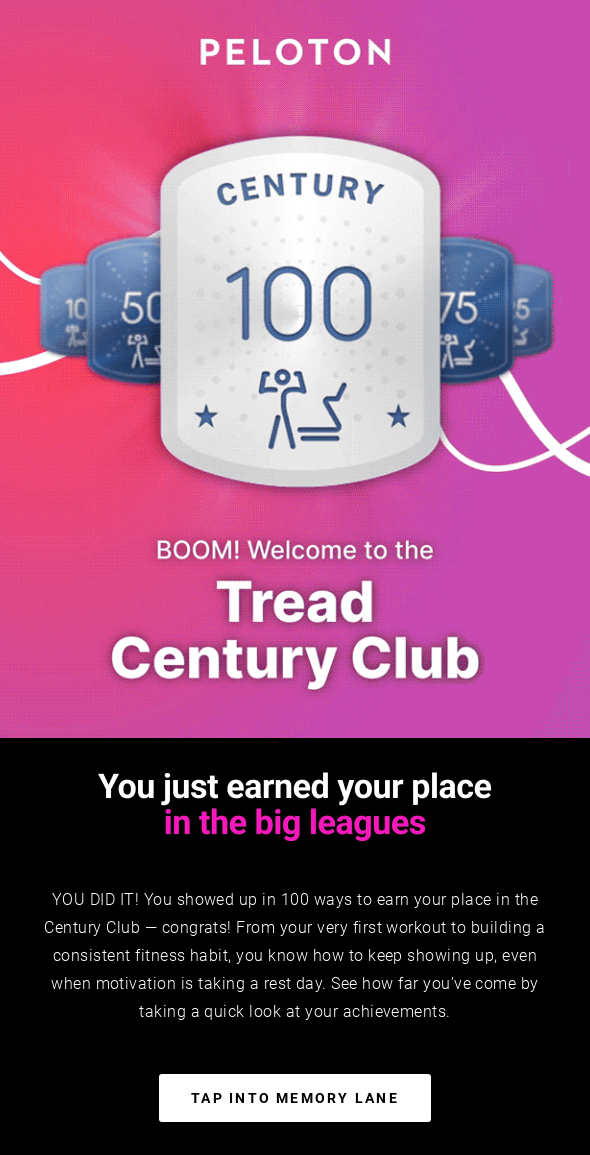
Fitness appliance leader Peloton sends automated milestone emails celebrating different stages of its customer journey. The example above celebrates the “Century Club,” where customers participate in 100 fitness activities.
Everything about it builds a sense of achievement, from the subject line “This is MAJOR: You just joined the Century Club” to the heading “You just earned your place in the big leagues.”
Peloton’s milestone email aims to reinforce customer loyalty and encourage them to continue using its products. The same goal applies to emails celebrating annual subscriptions, usage statistics, and account upgrades.
Key takeaways
- Milestone emails help build loyalty and encourage product use
- Create names for your milestones so they are part of your brand experience
- Provide recaps in your emails to remind customers about their journey
9. Simpler Hair Color — Automated education drip email
Subject line: 🎨 Wish your hair color would last?
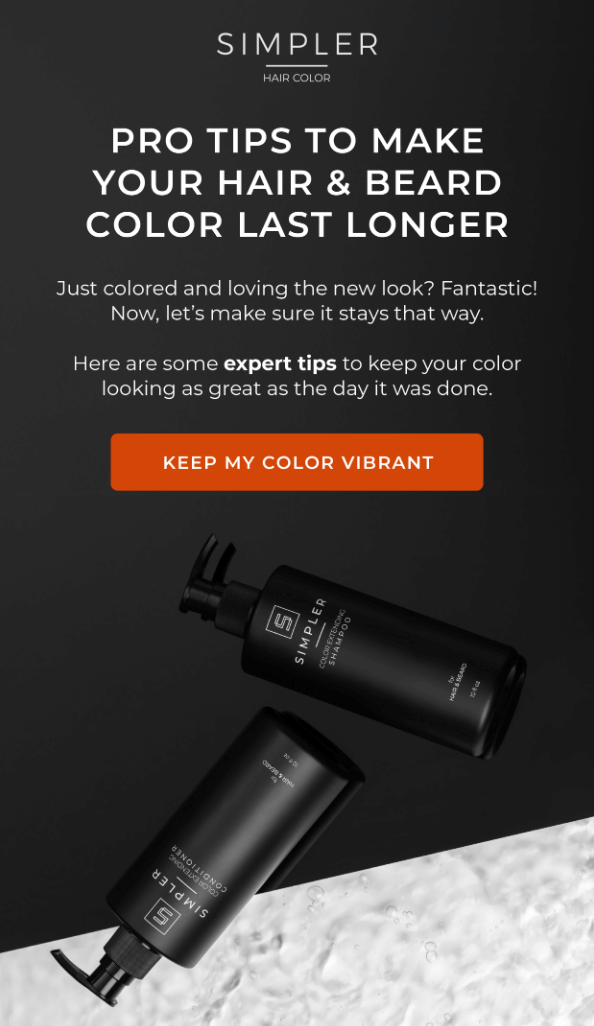
Hair and beard dye retailer Simpler Hair Color drips educational emails to its subscribers with tips directly related to product usage.
The email above includes tips to make your head and beard color last longer, with the enticing subject line “🎨 Wish your hair color would last?” Opening it reveals three tips, two of which include product links for shampoo and conditioner:
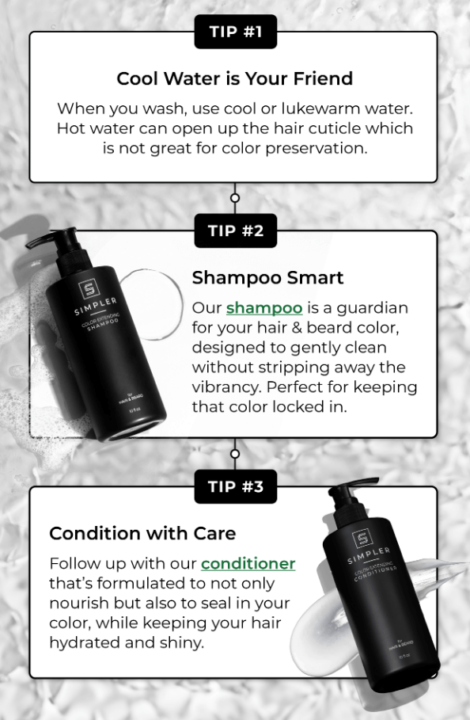
Key takeaways
- Dripping educational emails ensures optimal frequency
- Educational content helps customers understand products
- Turn your tips into shopping opportunities to increase sales
10. Best Day Brewing — Automated feedback request email
Subject line: Can We Ask You One Question? 🙏
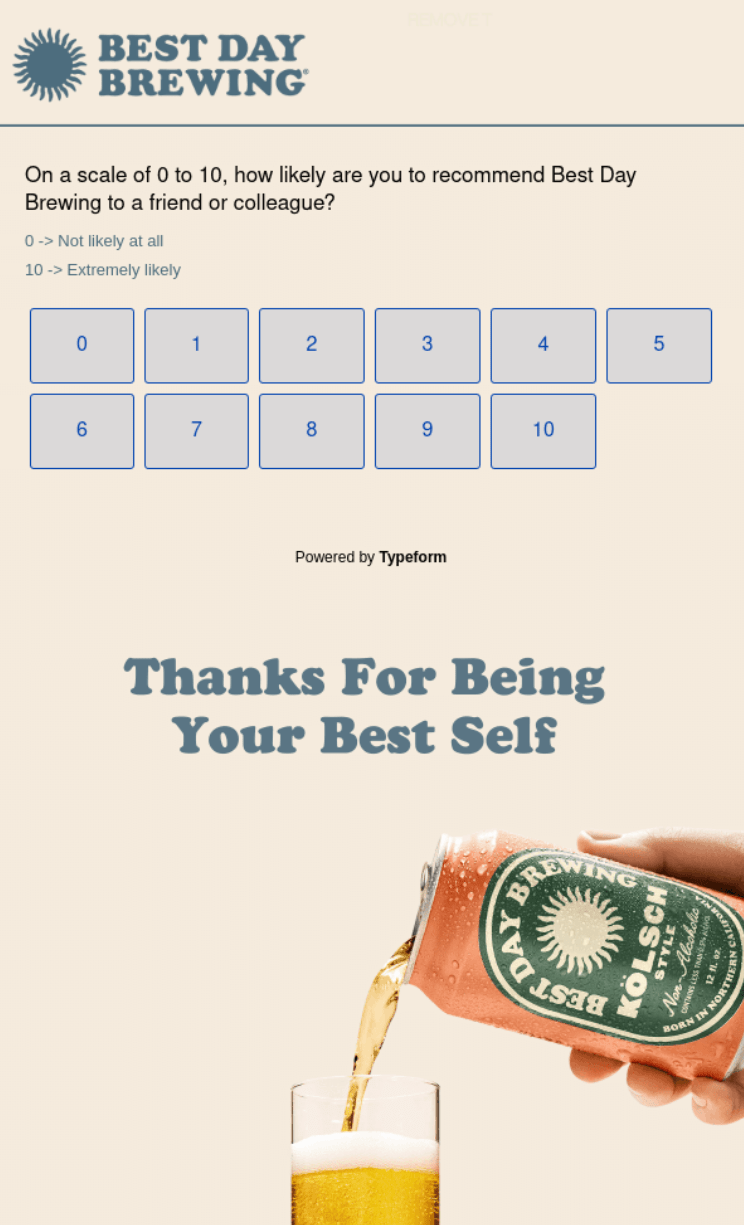
Non-alcoholic craft beer retailer Best Day Brewing integrates Typeform into its automated feedback emails. This allows customers to rate their experience on a scale of 0 to 10. All the customer needs to do is click a number to provide feedback.
Feedback emails that collect only ratings are more likely to convert due to ease of use. The more numerous and complex the steps, the less receptive your customers will be to filling in your form and being part of your post-purchase workflow.
Key takeaways
- Make it as easy as possible for customers to rate their experience
- Clearly explain what your customer should rate (e.g., delivery)
- Consider integrating with Typeform to add interactive elements to emails
11. Better Booch — Automated back-in-stock email
Subject line: Back in Stock On All Your Favorites
Better Booch has a back-in-stock flow for customers who subscribe to restock alerts. Its email opens with “Back In Stock” in massive text above product imagery that fills the frame. The subject line says the same thing, so there’s no confusion between inbox and open:
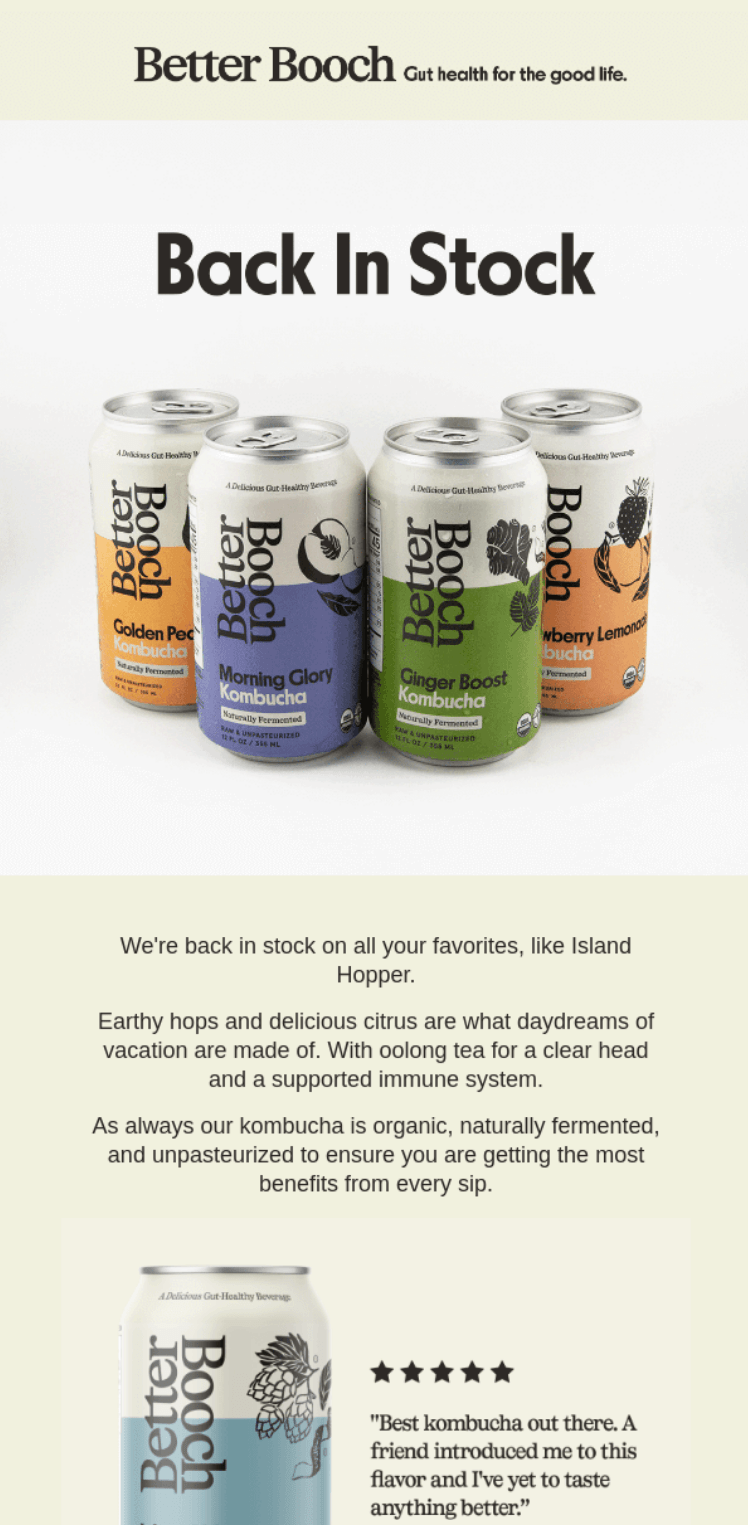
Four products appear at the top, but the copy focuses on one flavor instead of describing all of them, with the back-in-stock item getting a product image and a customer review.
All those elements sit against a neutral background that not only keeps focus on the products but also matches Better Booch’s website for a cohesive customer experience.
Key takeaways
- Put your biggest message and product image at the top
- Feature one restocked item instead of listing everything available
- Add testimonials and star ratings below the offer to reinforce the decision
12. Chewy — automated browse abandonment email
Subject line: Your browsed items are order-ready
Pet accessories retailer Chewy has a browse abandonment series that brings passive customers back to its store.
Its “Take a second look” subject line addresses browsing activity without adding guilt or fake urgency. Opening the email reveals an on-brand French Bulldog photo that grabs attention before the headline even registers:
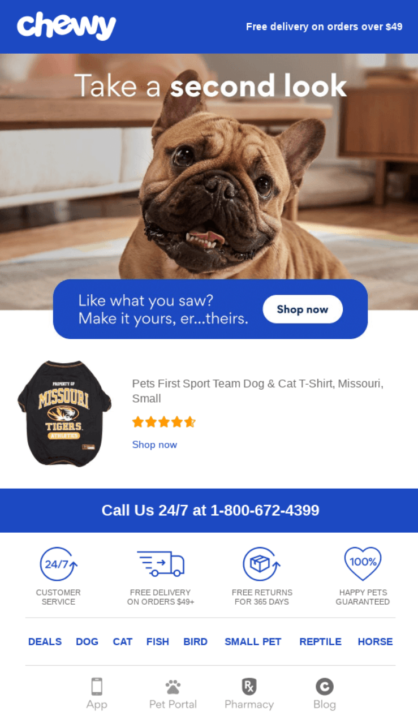
The first heading reads, “Like what you saw? Make it yours, er…theirs.” That self-correction from “yours” to “theirs” reminds pet owners they’re shopping for their animals.
A Missouri Tigers dog shirt appears below, matching what the recipient viewed, with star ratings beneath to build purchase confidence.
Key takeaways
- Stack trust signals to encourage shopping
- Use humor that connects to your audience’s mindset
- Show the product they browsed, not recommendations
13. Shake Shack — automated survey request email
Subject line: You’ve got great taste. And now we need your help
Shake Shack’s “Got a few minutes? Your taste matters” headline speaks directly to subscribers without corporate stiffness. A burger photo fills the top half, immediately connecting the request to food rather than abstract feedback:
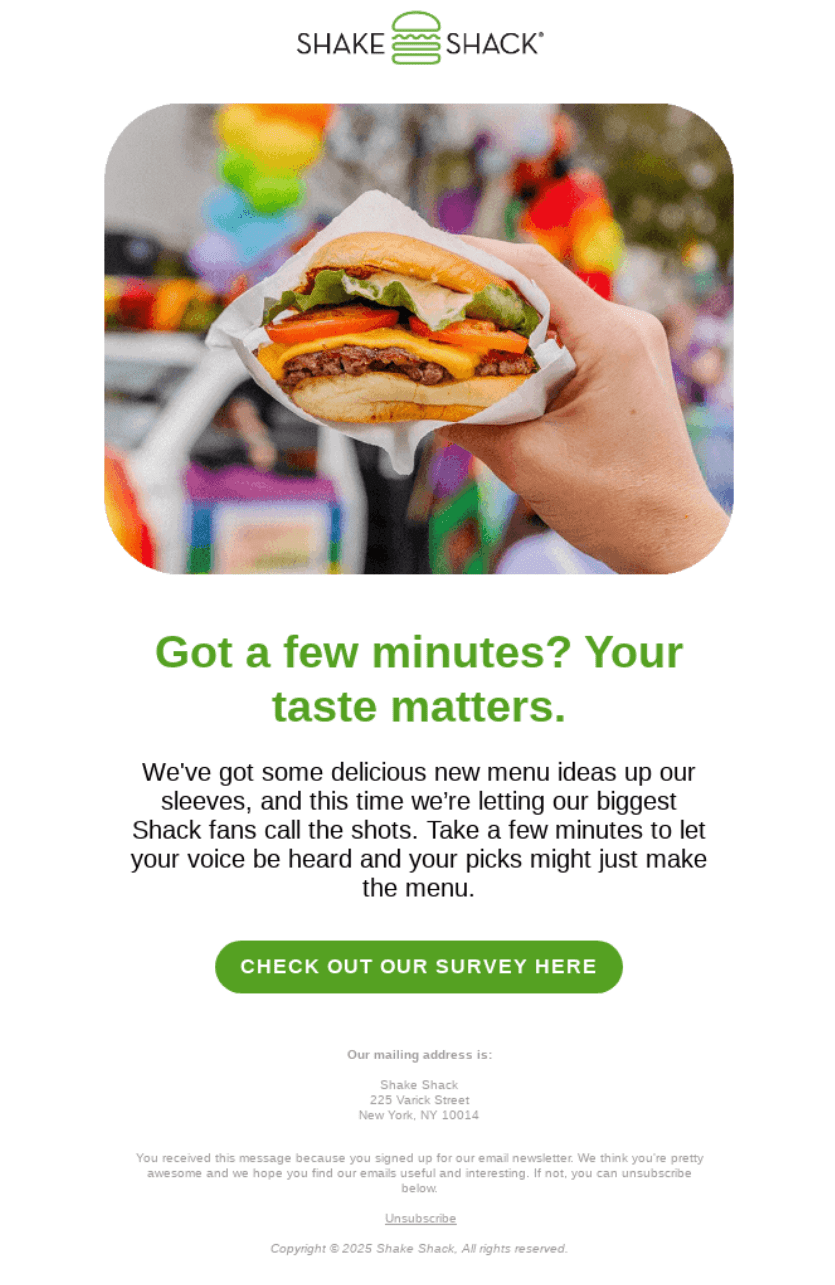
Explaining that fans will vote on new menu items turns the survey into something that feels collaborative instead of transactional. Phrasing like “your picks might just make the menu” creates investment in the outcome.
A single green CTA button (“CHECK OUT OUR SURVEY HERE”) sits below without competing elements. Brand colors stay consistent (green and white), keeping visual focus tight.
Key takeaways
- Frame surveys as opportunities to influence decisions, not chores
- Lead with product imagery to anchor the request
- Keep one CTA without additional links or distractions
14. Delta — automated booking confirmation email
Subject line: Your BNA > LIS Trip Details
Delta sends out booking confirmation emails following payment, ensuring its customers have flight details immediately when they need them most. “PREPARE FOR TAKEOFF” acknowledges the journey ahead instead of just rehashing the purchase:
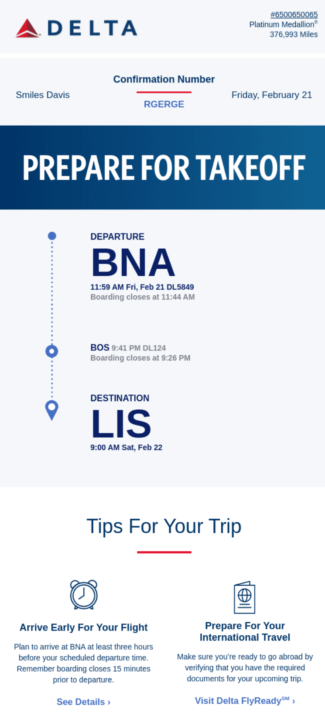
Its flight information section includes a progress graphic with all flight numbers, boarding times, and destinations in a scannable format. Below that, there’s a tips section for flight timing, packing, and mobile check-in (perfect for curious customers).
Key takeaways
- Make booking details the first thing customers see
- Include pre-trip tips that reduce support inquiries
- Layer promotional content below transactional information, not mixed in
15. Huel — automated checkout abandonment email
Subject line: Oops… What did we do wrong?
Huel flips the standard checkout abandonment approach by asking why the customer left instead of pushing them to buy. “Can we do more?” appears over a photo of someone holding their product, setting a tone of curiosity rather than desperation:
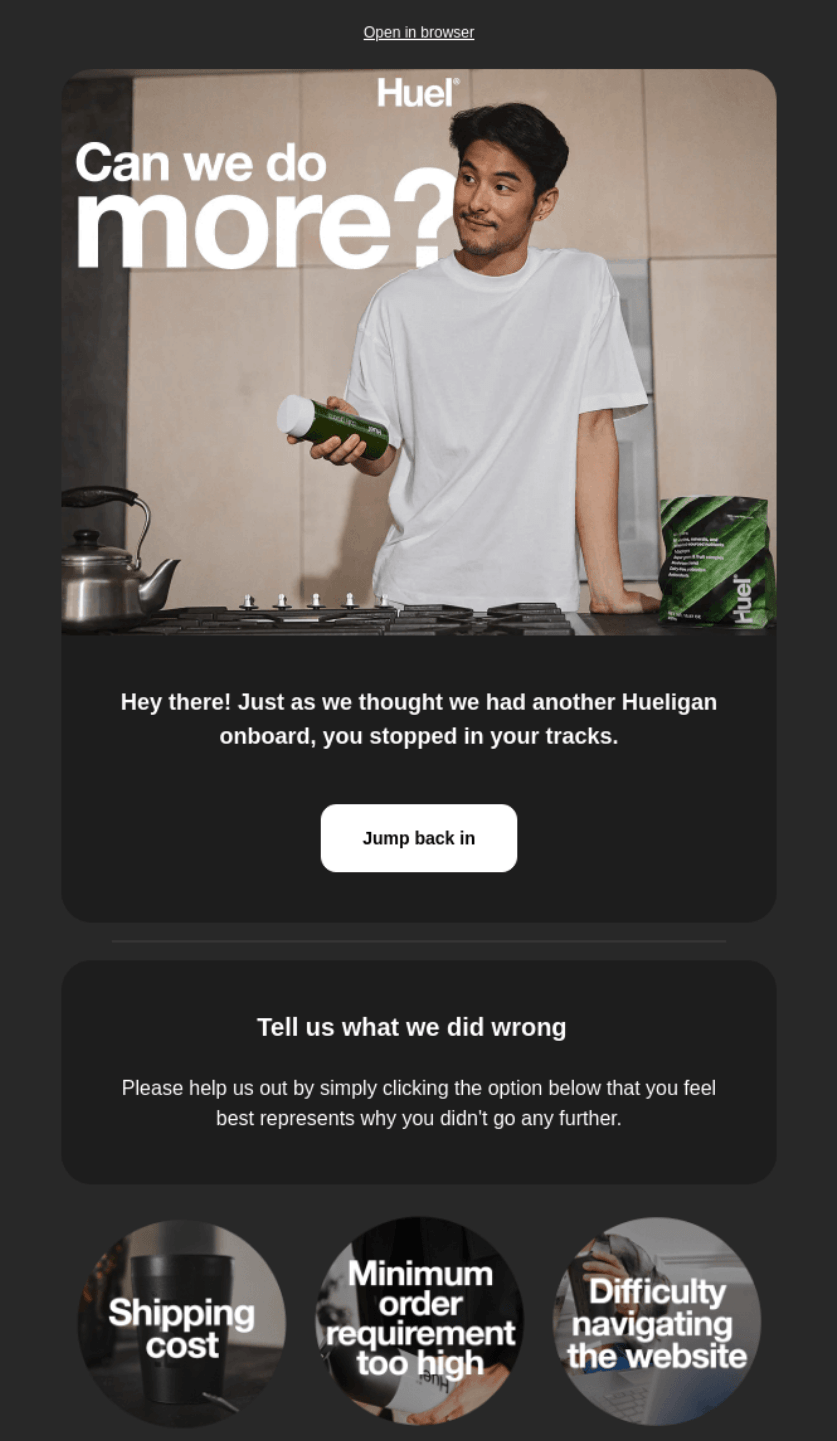
The copy acknowledges the abandonment directly, “Just as we thought we had another Hueligan onboard, you stopped in your tracks.” A “Jump back in” CTA encourages shopping, but doesn’t dominate.
The focus shifts to feedback collection with “Tell us what we did wrong,” followed by clickable options for shipping cost, minimum order requirement, and website navigation issues.
Most brands use checkout abandonment emails to recover revenue immediately. Huel uses them to understand why it lost revenue in the first place.
Key takeaways
- Ask why customers abandoned instead of only pushing purchase
- Provide clickable feedback options to reduce response friction
- Use the abandonment data you collect to fix systemic conversion problems
Let email automation do the work for you
Email automations help you create complete customer experiences from signup to win-back without any manual effort beyond their initial build times.
Automated emails appear at such opportune moments that if you only ever built a welcome series and thank-you flow, your store would still be streets ahead of many established retailers who haven’t locked down their strategy.
Of course, these flow examples account for a mere fraction of the opportunities you have to appear in your customers’ inboxes with automations. Add SMS into your flows, and the revenue potential is extreme, to say the least.
Omnisend’s Q1–Q3 2025 data shows that open rates never dip below 33% for the most popular automations, with conversions peaking at 6.41% for back-in-stock flows.
If you want in, you need an email automation tool. That’s your next step to generate maximum sales, revenue, and ROI.
Quick sign up | No credit card required
FAQs
Email automation sends messages triggered by customer actions or segment changes. Purchase confirmations, cart reminders, and welcome sequences go out when someone buys, abandons, or subscribes. Omnisend’s Q1–Q3 2025 data shows automated emails generated nearly 40% of email revenue despite representing just 3% of sends.
Get an email platform and connect your store. Import your list and split it into segments. Templates exist in some tools for welcome sequences, cart recovery, and browse abandonment if you want shortcuts. Build from zero if templates don’t fit what you’re doing.
Marketing is the big bucket. Campaigns sit inside it — you pick when they send. Automations sit inside it too, but they fire based on actions like cart abandonment.
Omnisend costs $16/month and includes workflows plus segmentation for ecommerce. Sender runs $10 and handles basic bulk sending. Kit charges $39, designed for people making content rather than selling products.
With an email tool offering a free plan. Omnisend offers unlimited workflows and lets you send 500 emails/month. Sender allows 2,500 contacts and 15,000 sends. Kit broadcasts to 10,000 subscribers without limits. EmailOctopus supports 2,500 subscribers and sends. However, only Omnisend lets you build complex flows in its free forever plan.
TABLE OF CONTENTS
TABLE OF CONTENTS


No fluff, no spam, no corporate filler. Just a friendly letter, twice a month.

 OFFER
OFFER







